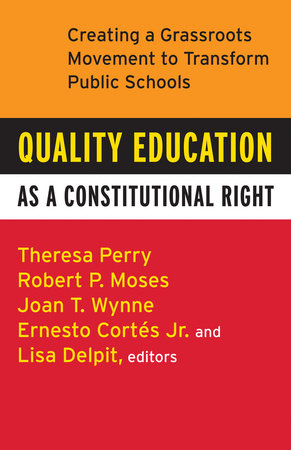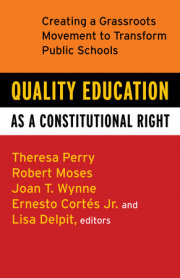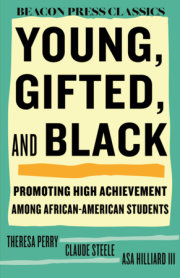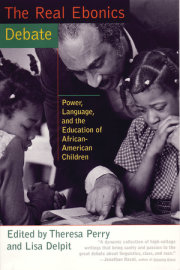From the Introduction by Theresa Perry
It is our hope that this book will be used to provoke discussion and debate in local communities and to support organizers in their efforts to find answers to these questions—what constitutes quality education, and what are the legislative routes towards getting the government to encode quality education as a protected right?
The book begins with an introductory essay by Linda Mizell. We noted that in early days after slavery, African Americans developed a movement to demand that the government protect their right to an education. Mizell provides us with an example of how this occurred in Florida in the early days of emancipation, during Reconstruction, and during the progressive era. According to Mizell, African Americans saw "education as
not simply a civil right or even as a human right, but as a divine right. For them, there was little distinction between political work, social uplift work, and education activism—
all of it was God’s work. . . . In a very real sense, every African American organization or institution of the period was an educational one—that is, with rare exception, no matter what the organization’s primary purpose, be it social, political, civic, cultural or fraternal, education was central to its mission and its work.” Mizell’s essay challenges us to bring these understandings to our contemporary organizing efforts.
In developing the Algebra Project, Bob envisioned young people as math literacy workers, who, like the SNCC workers of the sixties, would be the shock troops, demanding something of themselves and of the adults working in and making policy for schools and school systems. Charles Payne’s interview of the Baltimore Algebra Project students stands in stark contrast to the popular narrative about young Black youth as a group who don’t value education. The young people talk about their activism, give us details about their campaign for quality education, their sit-ins, mock trial of the state superintendent, and their systematic work with middle school students taking algebra. This was and is Bob Moses’s vision for the Algebra Project, the essence of what he learned from Ella Baker. It would be the youth who would lead the way.
The essays in part II by Jeannie Oakes, Bob Moses, Ernesto Cortés, and Imani Perry are designed to help us grapple with the following questions: Can the Constitution guarantee quality education? What are the routes that can lead us in that direction? What is the role of organizers in a legal fight? What coalitions are necessary? How can the fight for quality education be waged at the state, city, and federal levels? What new understanding of the law can be employed that will be likely to succeed at this time, when we have the first African American president in the White House and a Democratic Congress? How might the thirteenth amendment be used to support congressional legislation to encode into law and guarantee quality education?
Part III of this book begins with essays by two exemplary educators, Alicia Carroll, a kindergarten teacher, and Kimberly N. Parker, a high school teacher. These essays, along with essays by Joan T. Wynne and Janice Giles on Bob Moses’s summer math program for high school students, and Lisa Delpit on culturally responsive teaching, should prompt rich conversations and debates about what constitutes quality education. Can we codify a definition of quality? All of the essays in this section are meant to suggest that as we organize to make quality education a constitutionally guaranteed right, we have to be about the business of instantiating excellence in the meantime. The essays provide a starting point for local communities to begin conversations, grounded in practice, about what constitutes quality education. Over the two decades of the school reform movement, foundation money has supported school systems and school reform and policy organizations to discuss, propose, and enact visions of education for Black and Brown communities. It is time for our communities to begin to have these conversations. Tentative and ever-evolving answers to these questions will inform organizing efforts to make quality education a constitutionally guaranteed right.
For those of us committed to transforming sharecropper education to quality education, this is both a complicated and hopeful time. It is complicated because school reform has become a top-down phenomenon. We have seen the increasing disenfranchisement of local communities in decisions about schools and in discussion about the contents of public education. And as the public sphere has become demonized, so have public schools. Bob Moses has opined that we seem content to move students around and create ways for a few kids to get a better education, rather than trying to transform the system as a whole.
It is a hopeful time because there are stirrings of a renewed sense that government must play a role in addressing historic inequities. Youth are organizing, and disenfranchised communities are demanding quality education. While there are over forty state lawsuits related to the equalization of education, we have a better understanding of what has to happen, even if the plaintiffs are victorious, for equity to be actualized in schools.
President Obama’s victory on a campaign of hope opens imaginative possibilities. Imagine if President Obama talked straight to the nation, and specifically to the children and families in urban and rural communities, telling them, “I know I am asking you to pursue excellence in a context of inequities.” What if he said, “I know that in some of your schools you don’t have libraries, auditoriums, gyms, computers. But you still have to work hard and study hard. And I promise you, I will try and make it so that by the end of my second term all children have what they need to achieve in their schools”? What if he said that he was ushering in the next stage of the struggle for quality education? Imagine President Obama convening a working group of educators, youth and adult organizers, legal and educational scholars, charging them with developing an understanding of the resource requirements for an education in the twenty-first century and exploring how to encode these requirements in federal legislation that would make it a right for every child to have access to these resources in his or her school. Or to state it differently, what if he spearheaded the development of legislation that required states to deliver on these requirements with an accompanying authorization for federal funding to assist local and state governmental units meet their legislative responsibilities? When we heard that the money for school construction was being taken out of the stimulus package, many of us were disappointed. However, the real issue is that there is no federal requirement that the state or localities provide a floor of resources for our schools, urban or rural.
We all know that President Obama is the product of a White American mother and a Kenyan father, and that he lived and attended private schools in Indonesia and Hawaii. However, as a young adult, in his search for identity, he chose to identify as African American. He moved to Chicago, where Black means African American, organized on the south side of Chicago in the African American community, married an African American woman, and attended an Afrocentric African American church for close to twenty years. In these environments, he learned and gained facility in the use of Black language and in Black cultural practices, formal and informal, which have been on full display in his speeches and interactions during the campaign and since his election as president. We remember the fist bump that he and his wife, Michelle, shared on stage and his response to the cashier at the restaurant in Washington, D.C, when, after he was asked if he needed change, he said, “We straight.” We recall how in a campaign speech to a largely Black audience, he effectively used words that Spike Lee had attributed to Malcolm in the movie
Malcom X. He said, “They’re trying to bamboozle you. It’s the same old okey-doke. Y’all know about okey-doke, right?” In speaking about the extravagant lifestyles of bank executives, he excoriated them for living “high on the hog.” In his speeches, he used Black rhetorical style—repetition, rhythm, and actual phrases that are reminiscent of the words of Dr. Martin Luther King Jr.—and the preaching style of Black ministers generally: “They said this day would never come. They said our sights were set too high. They said this country was too divided.” Having located himself inside this tradition, he spoke in a way that had resonance for Black Americans particularly and at the same time spoke to all Americans.
Having chosen an African American identity, President Obama will, we hope, also claim his place in the African American tradition of seeing education as a path to freedom and will use the office of president to support these strivings.
Now is the time for ordinary people to be heard, to demand that the government at all levels (federal, state, and local) guarantee quality education, and for ordinary people to offer robust descriptions of quality education, ones that can be encoded in law and monitored by appropriate governmental agencies as well as an organized and vigilant public.
Copyright © 2010 by Perry, et. al.. All rights reserved. No part of this excerpt may be reproduced or reprinted without permission in writing from the publisher.






